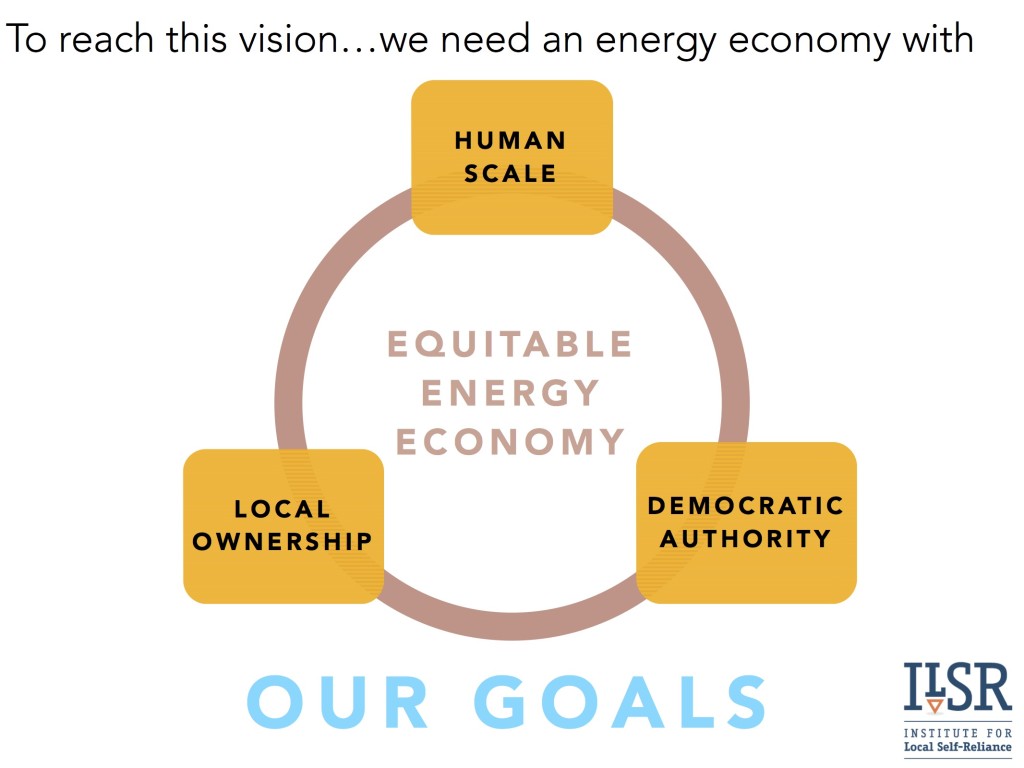Why Energy Democracy Offers A Faster Approach To Clean Energy
Originally published on ilsr.org.
There are many organizations in the energy space, and ILSR’s climate and energy advocacy overlaps substantially with the many other players who care about a cleaner energy system. But our approach isn’t the same.
Rather, our vision is that communities enrich their local economies by being masters of the transition to 100% renewable energy. This approach works best not only because it marries authority and responsibility, leaving communities in charge of their own fate, but because it is a political strategy that builds a movement for more ambitious and rapid change in the energy economy. It’s a vision we’ve been helping implement for over 40 years.
Consider the situation. The forces arrayed against a clean energy economy are large, powerful, well financed, and ultimately have a vested economic interest in resisting change. Our success thus far has been largely on the margins — even now, just 17% of electricity in the U.S is from renewable energy. Truly transformational change will require the incumbents to lose ground on their sunk investments in power plants that burn things and fuels that pollute. That represents $28 trillion in value (or more) that they must be forced to abandon.
Victory comes through countervailing political power, which requires a mighty movement of morally and economically motivated Americans to compel these companies to release their grip on this financial windfall.
But movement building won’t happen by simply transitioning a multinational corporation from one extractive energy generation method to another. Motivating Americans across the political spectrum requires a vision the unites Tea Party opponents of monopoly electric companies with Greenpeace opponents of oligopoly fossil fuel companies. This vision requires three crucial elements, which are our goals for the energy system: human scale, local ownership, and democratic authority.
 Chip in a few dollars a month to help support independent cleantech coverage that helps to accelerate the cleantech revolution!
Chip in a few dollars a month to help support independent cleantech coverage that helps to accelerate the cleantech revolution!
These three elements rely on each other:
- Democratic energy: an energy system that is within the purview of our elected government and not controlled by monolithic, multinational corporations. Such an energy system must be humanly-scaled, to prevent large-scale control. Such a system is much more likely to be democratically controlled if ownership and economic benefits are widely dispersed.
- Local ownership: a system where many residents of the community are owners of the means of producing energy. Local ownership requires human scale and is enabled best when locally-controlled democratic authority writes the rules to level the playing field.
- Democratic authority: a system where the structure of our control over the energy system ultimately resides in bodies that are democratically elected and accessible to the average citizen.
Pursuing an equitable energy system that is community-owned and community-driven means a different approach to energy policy than most advocate. We desire energy policies that:
- Elevate local authority, responsibility, and capacity, recognizing that communities see and pursue their environmental and economic self-interest. We see this in Georgetown, TX, where the municipal utility is have a 100% renewable energy supply by 2017, from nearby wind and solar energy. Rules that enable communities include municipalization laws, community choice aggregation, local authority to exceed state building energy codes, and local energy financing (e.g. PACE).
- Focus on the capture of energy dollars rather than energy prices. We believe that it’s better to pay $1.10 per unit of energy and keep half in the local economy than to pay $1.00 and retain just 10¢. Rules like Ontario’s “buy local” feed-in tariff or Minnesota’s “made in Minnesota” solar incentive help keep energy dollars at home. These policies are a necessary layer over blanket renewable energy standards that leave the development of renewable energy in the hands of monopoly utilities.
- Maximize ownership opportunities, such as community solar gardens, distributed generation carve outs, and other tools for keeping energy production humanly-scaled. These policies aid in the development of more locally owned energy, and more capture of local energy dollars.
- Exercise local authority, such as building energy use disclosure, local taxing authority, local solar mandates, and use of zoning, licensing, and permitting.
Together, these approaches accelerate our progress toward a 100% renewable, climate-friendly energy system even better than the traditional tools. That’s because rules that create an equitable, local energy economy will give more Americans a vested, economic self-interest in the 100% renewable energy transition and not just a moral or emotional one. And given the 28 trillion reasons the big fossil fuel interests have in resisting this transition, we’re going to need every energy American we can get on our side.
For timely updates, follow John Farrell on Twitter or get the Energy Democracy weekly update.
Have a tip for CleanTechnica? Want to advertise? Want to suggest a guest for our CleanTech Talk podcast? Contact us here.
Latest CleanTechnica.TV Video

CleanTechnica uses affiliate links. See our policy here.

